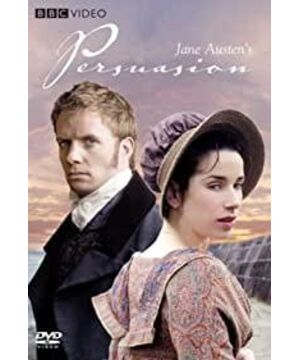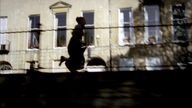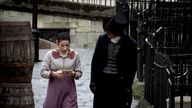The first is the clothing aspect. In 2007, the actor's clothing style is simple, but it has a lot of articles.
Young girls such as Henriette and Louisa, with their white and elegant dresses running lightly and laughing on the green lawn, are carefree years, and their emotions can easily fly and fall in the flowers like white butterflies. Anne, who is only 27 years old, wears skirts of pearl gray and other colors. Her youth has quietly passed away, and the short and strong love of the past has turned into a pink-purple bead in the dark. hoarsely lit.
Most of the male characters wear black and white (except for the hunting suit of the third sister and her husband, haha). The lawyer Sheppard wears it with round-frame glasses. He is dedicated and humble, with a hint of insight and shrewdness; he has an aura of arrogance Sir Walter wore it and leaned in front of the mirror with his little curls, it was so stinky; Colonel Wentworth, who was emotionally wounded, wore it to laugh at himself, flirt, snoop and stare affectionately, switching resentment and affectionate modes repeatedly. No aesthetic fatigue.
Followed by the scene, there are two places that impressed me the most. The first is at the beginning. After a brief moment of silent thinking, Annie continued to turn around and get busy. The long shot followed Annie as she hurriedly shuttled through the long aisle full of furniture, while the servants silently did the final finishing. The rapid background music followed step by step, as if to drive Annie away. For an unknown period of time thereafter, the prosperity of Kalynch will no longer belong to Annie and the Elliott family. In the original book, this scene is not overwritten, just a brushstroke. And this is just a microcosm of Anne's eight-year trivial life. In other versions, such as the 1975 version, Anne's ingenious handling in Upper Cross is not as wonderful as it is here.
The second is on the seawall of Lyme. The scenery of Lyme in the original book is beautiful and fascinating, leaving a good memory in Annie's heart. The 2007 film uses the trip to Lyme as a narrative background, compactly explaining the precious friendship between Javier and Benwell and Wentworth, Mr. Elliott's debut, and Louisa's accident. Clear and neat. Lyme seaside, the sky is gloomy, the sea breeze is whistling, the seagulls are neighing, the waves are lapping on the reefs, and the waves splash on the embankment from time to time. In front of the magnificent natural scenery, rhetoric often seems contrived. So, a group of people, or talking with each other, or walking hand in hand, or peeping at the sea alone, thoughtfully, is really wonderful! The most comfortable way for a group of people to get along is to take a walk, and Jane Austen's people especially love walking (haha~). I especially like the male and female protagonists to peek at each other. Ahaha~ (YY Small Theater heroine: "I'm looking at the sea, I'm not looking at you~" Male protagonist: "I'm also looking at the sea, I'm not looking at you!")
Once again, it's the plot, the 2007 version was changed more Great, I believe that everyone who has read the original work has discovered it, so I will not repeat how to change the law again here. The revised plot intensifies the conflict, the narrative is more compact, and the progress of the plot is accelerated. (Halo ~ said is equal to not said ~). But I have some regrets about the changed version. After the revision, the screenwriter moved the dialogue between Colonel Javier and Annie about who is more loyal between men and women to Benwell. This is the biggest contradiction. Benwell's wife died half a year ago and then moved away from love, ha. Will only be qualified to complain~ and this also makes the scene of Wentworth's letter in front of Anna unable to appear, alas~~~
In short, the 2007 version is more in line with my personal perception, and the cold and hard wind is very in line with the "persuasion" in my mind. The word Persuasion has undeniable power, and even carries a compelling authority. Anne, who was only 19 years old, rejected Wentworth in front of it. Whether it was out of submission or real rational thinking, I personally think the two are mixed. There's even a bit of timid cowardice mixed in (though the author thinks Anne was really thinking of Wentworth's future). Every reader of "Persuasion" understands Annie differently. The director saw Annie change from cowardice to firmness, and finally ran up to catch up with Wentworth. And that's what I like the most, this arrangement seems to be a chance for all of us who have lost love through cowardice. I really want to say to you: please forgive my cowardice, please give me another chance, please wait for me!
View more about Persuasion reviews











